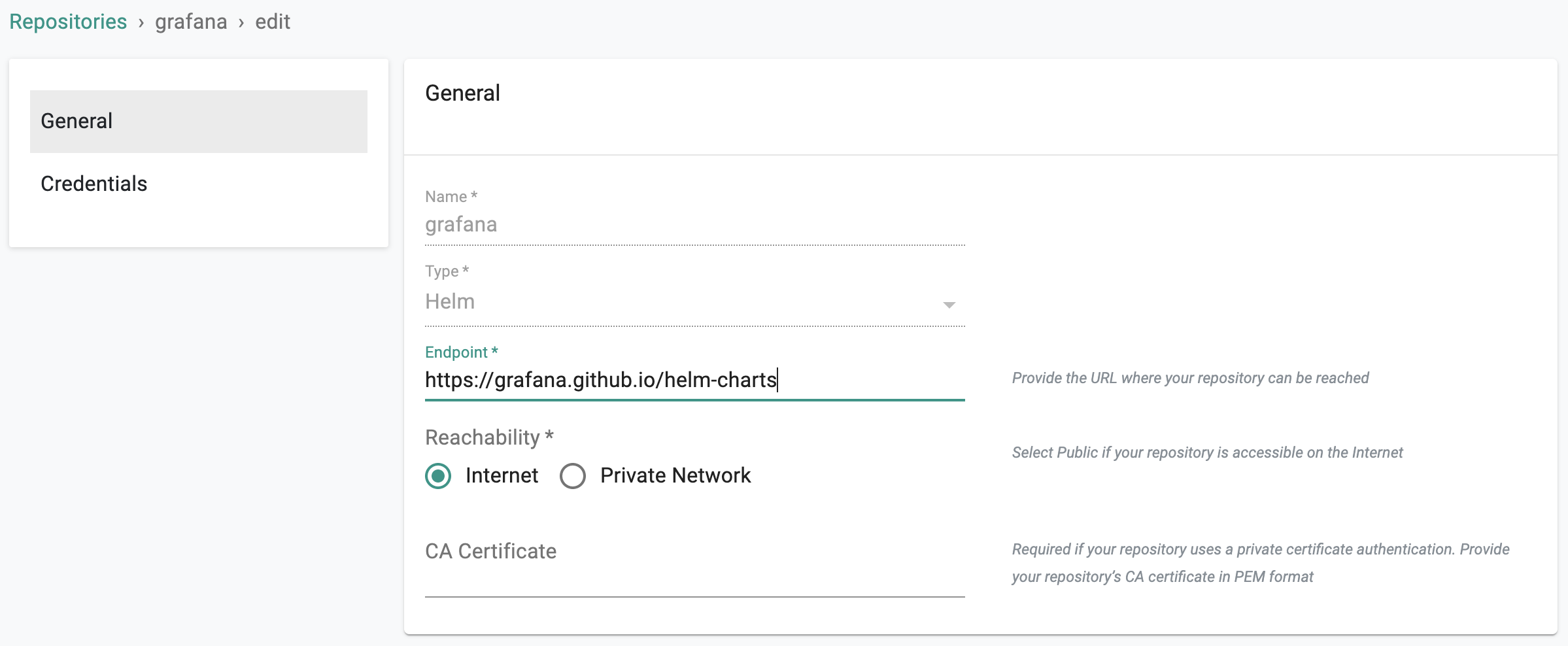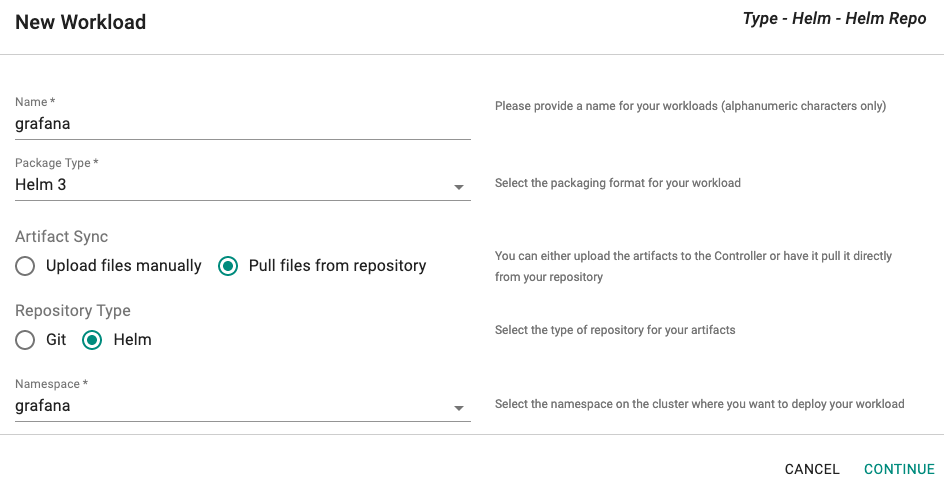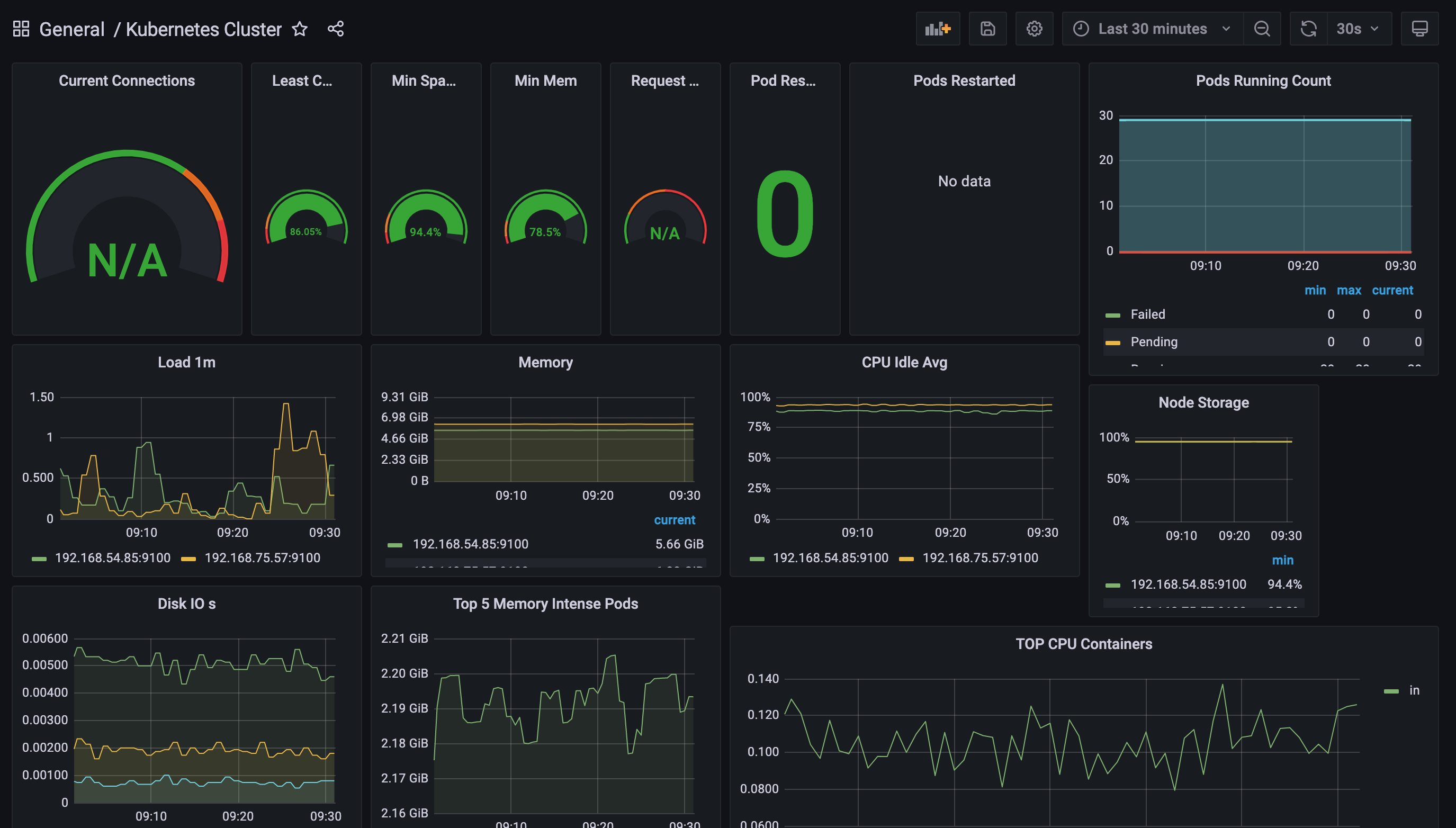Access
In this part, you will
- Create an IRSA for Grafana to read from the AMP workspace.
- Configure and Deploy a Grafana workload to your EKS cluster.
- Access the Grafana dashboard to view the aggregated metrics from the AMP workspace.
Step 1: IRSA¶
In this step, you will create an IRSA so that Grafana on the EKS cluster will have the necessary permissions to perform "remote reads" from the AMP query endpoint. In AWS, it is a recommended best practice to use IAM roles for service accounts (IRSA) to access AWS services outside the EKS cluster.
Create Namespace¶
We will deploy Prometheus to a namespace called "grafana"
- Click on Infrastructure -> Namespace.
- Create a new namespace with the name "grafana".
Create IRSA¶
In the example below, the EKS cluster's name is "amp-demo" and the IRSA name is "grafana-amp-irsa".
./rctl create iam-service-account amp-demo --name grafana-irsa --namespace grafana --policy-arn arn:aws:iam::aws:policy/AmazonPrometheusQueryAccess
Request submitted successfully to create IAM service account(s).
Verify IRSA¶
Creation of the IRSA can take a few seconds. You can verify the status of the IRSA by using RCTL
./rctl get iam-service-account amp-demo --namespace grafana
[{"metadata":{"name":"grafana-irsa","namespace":"grafana"},"attachPolicyARNs":["arn:aws:iam::aws:policy/AmazonPrometheusQueryAccess"]}]
You can also verify that the k8s service account was created in the EKS cluster in the "grafana" namespace.
- Click on the Zero Trust Kubectl Shell on the web console.
kubectl get sa -n grafana
NAME SECRETS AGE
default 1 56s
grafana-irsa 1 56s
As you can see in this example, the "grafana-irsa" service account was successfully created in the "grafana" namespace.
Step 2: Grafana¶
In this step, we will configure and deploy a Grafana workload to the EKS Cluster. We will use a custom values.yaml file which will incorporate the IRSA for Grafana from the prior step.
Add Grafana Repo¶
Configure the Grafana repo endpoint so that the controller can automatically retrieve the required Helm chart directly from the official Internet facing repository.
- Click on Integrations -> Repository.
- Create New Repository -> Provide a name such as "grafana" and Select "Helm" for Type.
- Enter "https://grafana.github.io/helm-charts" for endpoint and Select "Internet Facing" for reachability.

Create Workload¶
- Click on Application -> Workloads.
- Click on Create New Workload with the name "grafana".
- Select "Helm3" for addon type.
- Select "Pull files from repository" for Artifact Sync.
- Select the "grafana" namespace from the dropdown.
For repository configuration, - Select the "grafana" repository from the dropdown. - Enter "grafana" for chart name.

Custom Values¶
We need to customize the Grafana Workload with an override "values file" comprising the following:
- The IRSA for Grafana to perform remote queries to the AMP workspace
- The AMP query endpoint URL details (from AWS Console)
- The AWS region for the AMP workspace
- EKS cluster name
Note
From the AMP query endpoint URL, remove the /api/v1/query string that is appended to the URL, because the Prometheus data source will automatically append it.
- Save the YAML provided below to a file and update the fields appropriately.
- Add the values.yaml file to the workload's override YAML.
serviceAccount:
create: false
name: <IRSA for Grafana>
grafana.ini:
auth:
sigv4_auth_enabled: true
service:
type: LoadBalancer
adminPassword: "Admin Password for Grafana"
datasources:
datasources.yaml:
apiVersion: 1
datasources:
- name: <Name of EKS Cluster>
type: prometheus
url: <URL for Query Endpoint for AMP Workspace>
access: proxy
jsonData:
sigV4Auth: true
sigV4AuthType: default
sigV4Region: <AWS Region for AMP Workspace>
isDefault: true
dashboardProviders:
dashboardproviders.yaml:
apiVersion: 1
providers:
- name: 'default'
orgId: 1
folder: ''
type: file
disableDeletion: false
editable: true
options:
path: /var/lib/grafana/dashboards/default
dashboards:
default:
k8sClusterDashboard:
gnetId: 7249
datasource: <Name of EKS Cluster>
k8sClusterResource:
gnetId: 12114
datasource: <Name of EKS Cluster>
k8sNamespaceResource:
gnetId: 12117
datasource: <Name of EKS Cluster>
k8sPodResource:
gnetId: 12120
datasource: <Name of EKS Cluster>
k8sNodeResource:
gnetId: 12119
datasource: <Name of EKS Cluster>
k8sNodeExporter:
gnetId: 11074
datasource: <Name of EKS Cluster>
k8sDeployStsDs:
gnetId: 8588
datasource: <Name of EKS Cluster>
k8sAppMetrics:
gnetId: 1471
datasource: <Name of EKS Cluster>
k8sNetworkingCluster:
gnetId: 12124
datasource: <Name of EKS Cluster>
k8sNetworkingNamespace:
gnetId: 12125
datasource: <Name of EKS Cluster>
k8sNetworkingPod:
gnetId: 12661
datasource: <Name of EKS Cluster>
Publish Workload¶
- Select the EKS Cluser for Placement
- Publish the grafana workload
In a few seconds, the Load Balancer should be available and you can retrieve the public URL using kubectl
kubectl get services
NAME TYPE CLUSTER-IP EXTERNAL-IP PORT(S) AGE
grafana LoadBalancer 10.100.155.117 a23f54aa0bd2c40d9920.us-west-1.elb.amazonaws.com 80:31274/TCP 5m12s
Step 3: Access Grafana¶
- Navigate to the Load Balancer's public URL to access Grafana.
- Use "admin" for the username and the admin password you set in your custom values.yaml file to view the Grafana dashboards.

- Navigate to Dashboards and select any dashboard to view the data.

Congratulations! You can now use Grafana to view the metrics aggregated in your AMP workspace.